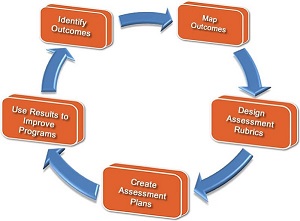Closing the Assessment Loop
Pretty curriculum maps, assessment data reports, and even archived syllabi indeed tell a story about your college's curriculum. But when assessment data suggests a gap in student learning, what do you do? Gaps in student success require attention and strategies for continuous improvement of student learning. Improvements can range from more concise performance criteria to increased practice activities to re-designing skill assessment.

WIDS is a robust, online curriculum management system where colleges can define and map outcomes, design rubrics and assessment plans, and then use assessment results for continuous improvement of student learning. In WIDS, a college can see where program outcomes are introduced, practiced, and assessed. Look deeper into program courses to see where gaps exist, and then revise learning experiences and assessment strategies to help drive improvement. The assessment loop closes when assessment results support the criteria for student success. Now, that's a pretty picture!
Use the WIDS software to:
- Identify Outcomes: Define outcomes – college wide, program, and course. Then, align them to each other and accrediting standards.
- Map Outcomes: Give faculty an easy way to visualize where outcomes are taught and assessed with a matrix report.
- Design Assessment Rubrics: Create simple and complex rubrics for assessing learning outcomes. Design your own, or use the WIDS assessment library to jumpstart your efforts.
- Create an Outcome Assessment Plan: Use a customizable template to design assessment plans that point to those rubrics and define the standard for student success
- Report Results: Document assessment results. Compare results against standards for success. Recommend changes to support continuous improvement.
Download a free sample of a WIDS Curriculum Map and an Outcome Assessment Plan to see how to build continuious improvement of student learning and assessment. Contact us to learn more about closing the assessment loop.
8566